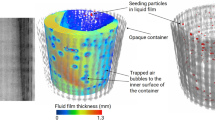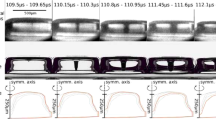Abstract
To measure the void fraction distribution in gas–liquid flows, a two-dimensional X-ray densitometry system was developed. This system is capable of acquiring a two-dimensional projection with a 225 cm2 area of measurement through 21 cm of water. The images can be acquired at rates on the order of 1 kHz. Common sources of error in X-ray imaging, such as X-ray scatter, image distortion, veiling glare, and beam hardening, were considered and mitigated. The measured average void fraction was compared successfully to that of a phantom target and found to be within 1 %. To evaluate the performance of the new system, the flow in and downstream of a ventilated nominally two-dimensional partial cavity was investigated and compared to measurements from dual-tip fiber optical probes and high-speed video. The measurements were found to have satisfactory agreement for void fractions above 5 % of the selected void fraction measurement range.





















Similar content being viewed by others
Abbreviations
- BFS:
-
Backward-facing step
- ESF:
-
Edge spread function
- FFT:
-
Fast Fourier transform
- II:
-
Image intensifier
- LSF:
-
Line spread function
- TTL:
-
Transistor–transistor logic
- PSF:
-
Point spread function
- RMSD:
-
Root-mean-square deviation
- SNR:
-
Signal-to-noise ratio
- 2D:
-
Two-dimensional
- a i :
-
Fraction of light scatter contributed by term i
- b i :
-
Measure of propagation distance of scattered light by term i
- d :
-
Bubble diameter (m)
- D :
-
The detected image
- E :
-
The un-degraded image
- f e :
-
Bubble probe sampling frequency (1/s)
- H :
-
Height of the backward-facing step (127 mm)
- \(\widehat{H}\) :
-
Fourier transform of h
- h :
-
Point spread function (1/m2)
- I :
-
Intensity of photon flux, number of photons per unit area and time (1/(m2s))
- G :
-
Gray scale value of light intensity (1)
- K :
-
Number of X-ray image frames
- L :
-
Length (m)
- l 12 :
-
Streamwise distance between the optical probe’s tips (m)
- l L :
-
Latency length of the optical probe’s tips (m)
- l c :
-
Chord length of the gas measured by the upstream tip of the optical probe (m)
- N :
-
Total number of materials (1)
- n b :
-
Number of gas structures detected on the upstream tip of optical probe
- Q :
-
Injected air volume flow rate (m3/s)
- Q det :
-
Image intensifier detection efficiency
- q :
-
Non-dimensional gas flow rate, Q/UHW (1)
- r :
-
Radial distance (m)
- Re :
-
Reynolds number, UL/ν (1)
- t :
-
Time (s)
- t a :
-
Transit time of a gas structure between the two tips of the optical probe(s)
- t aP :
-
Most probable transit time of gas structures (s)
- T :
-
Measurement time of the bubble probe (s)
- U :
-
Free-stream velocity at the BFS (m/s)
- U a :
-
Gas velocity (m/s)
- \(\overline{U}_{a}\) :
-
Statistical mean value of the gas velocity (m/s)
- U aP :
-
Most probable velocity of the gas (m/s)
- U w :
-
Water velocity (m/s)
- W :
-
Width of the model (209.6 mm)
- v :
-
Bubble probe signal voltage (V)
- V :
-
Photon energy (eV)
- x n :
-
Mass thickness of material, n (kg/m2)
- x :
-
Coordinate along the test surface, zero at the BFS (m)
- y :
-
Coordinate normal to the test surface (m)
- z :
-
Spanwise coordinate (m)
- α :
-
Void fraction (1)
- δ :
-
Boundary layer thickness (m)
- Δ:
-
Linear dimension of a square on imager
- ε α :
-
Error in void fraction (1)
- ρ :
-
Density (kg/m3)
- θ :
-
Momentum thickness (m)
- σ :
-
Surface tension (N/m)
- ν :
-
Kinematic viscosity (m2/s)
- μ n /ρ n :
-
Mass attenuation coefficient of material n (m2/kg)
- a :
-
Air
- i, j :
-
Number of term
- inj:
-
Injection
- k :
-
Frame number
- m :
-
Mixture
- min:
-
Minimum
- max:
-
Maximum
- n :
-
Material designator (air, water, mix, etc.)
- OP:
-
Optical probe
- w :
-
Water
- 0:
-
Initial
- 2:
-
Two-dimensional
References
Adams EW, Johnston JP (1988) Effects of the separating shear layer on the reattachment flow structure part 2: reattachment length and wall shear stress. Exp Fluids 6(7):493–499
Aeschlimann V, Barre S, Legoupil S (2011) X-ray attenuation measurements in a cavitating mixing layer for instantaneous two-dimensional void ratio determination. Phys Fluids 23:055101
Alles J, Mudde RF (2007) Beam hardening: analytical considerations of the effective attenuation coefficient of X-ray tomography. Med Phys 34(7):2882. doi:10.1118/1.2742501
Bushberg JT, Seibert JA, Leidholdt EM Jr, Boone JM (2001) The essential physics of medical imaging, 2nd edn. Lippincott Williams & Wilkins, Philadelphia
Cartelier A (1990) Optical probes for local void fraction measurements: characterization of performance. Rev Sci Instrum 61(2):874–886
Ceccio SL, George DL (1996) A review of electrical impedance techniques for the measurement of multiphase flows. J Fluids Eng 118(2):391–399
Cerveri P, Forlani C, Borghese NA, Ferrigno G (2002) Distortion correction for X-ray intensifiers: local unwarping polynomials and RBF neural networks. Am Assoc Phys Med 29(8):1759–1771
Cho J, Perlin M, Ceccio SL (2005) Measurement of near-wall stratified bubbly flows using electrical impedance. Meas Sci Technol 16(4):1021–1029
Clark NN, Turton R (1988) Chord length distributions related to bubble size distributions in multiphase flows. Int J Multiphase Flow 14(4):413–424
Coutier-Delgosha O, Stutz B, Vabre A, Legoupil S (2007) Analysis of cavitating flow structure by experimental and numerical investigations. J Fluid Mech 578:171–222
Elbing BR, Winkel ES, Lay KA, Ceccio SL, Dowling DR, Perlin M (2008) Bubble-induced skin-friction drag reduction and the abrupt transition to air-layer drag reduction. J Fluid Mech 612:201–236
Gabillet C, Colin C, Fabre J (2002) Experimental study of bubble injection in a turbulent boundary layer. Int J Multiphase Flow 28:553–578
George DL, Iyer CO, Ceccio SL (2000a) Measurement of the bubbly flow beneath partial attached cavities using electrical impedance probes. J Fluids Eng 122:151–155
George DL, Torczynski JR, Shollenberger KA, O’Hern TJ, Ceccio SL (2000b) Validation of electrical impedance tomography for measurement of material distribution in two-phase flows. Int J Multiphase Flow 26:549–581
Hassan W, Legoupil S, Chambellan D, Barre S (2008) Dynamic localization of vapor fraction in turbo pump inducers by X-ray tomography. IEEE Trans Nucl Sci 55(1):656–661
Heindel TJ (2011) A review of X-ray flow visualization with applications to multiphase flows. J Fluids Eng 133(7):074001. doi:10.1115/1.400436
Holder D (2005) Electrical impedance tomography: methods, history, and applications. IOP publishing, Bristol
Hubbell JH, Seltzer SM (2004) Tables of X-ray mass attenuation coefficients and mass energy-absorption coefficients (version 1.4). National Institute of Standards and Technology, Gaithersburg, MD. http://www.nist.gov/pml/data/xraycoef/index.cfm. Accessed 27 June 2011
Hubers JL, Striegel AC, Heindel TJ, Gray JN, Jensen TC (2005) X-ray computed tomography in large bubble columns. Chem Eng Sci 60:6124–6133
Johnson CB (1973) Point-spread functions, line-spread functions, and edge-response functions associated with MTFs of the form exp [- (w/w_r)^n]. Appl Opt 12(5):1031–1033
Julia JE, Harteveld WK, Mudde RF, Den Akker HEAV (2005) On the accuracy of the void fraction measurements using optical probes in bubbly flows. Rev Sci Instrum 76:35103
Mäkiharju SA (2012) The dynamics of ventilated partial cavities over a wide range of Reynolds numbers and quantitative 2D X-ray densitometry for multiphase flow. Ph.D. thesis, University of Michigan
Oweis G, Choi J, Ceccio SL (2004) Measurement of the dynamics and acoustic transients generated by laser induced cavitation bubbles. J Acoust Soc Am 115:1049–1058
Poludniowski G, Landry G, DeBlois F, Evans PM, Verhaegen F (2009) SpekCalc: a program to calculate photon spectra from tungsten anode X-ray tubes. Phys Med Biol 54(19):N433–N438. doi:10.1088/0031-9155/54/19/N01
Poludniowski G, Evans PM, Kavanagh A, Webb S (2011) Removal and effects of scatter-glare in cone-beam CT with an amorphous-silicon flat-panel detector. Phys Med Biol 56(6):1837–1851. doi:10.1088/0031-9155/56/6/019
Seibert JA, Boone JM (1988) Scatter removal by deconvolution. Med Phys 15(4):567
Seibert JA, Nalcioglu O, Roeck WW (1984) Characterization of the veiling glare PSF in X-ray image intensified fluoroscopy. Med Phys 11(2):172
Seibert JA, Nalcioglu O, Roeck W (1985) Removal of image intensifier veiling glare by mathematical deconvolution techniques. Med Phys 12(3):281
Smith EH (2006) PSF estimation by gradient descent fit to the ESF. In: Proceedings of SPIE, 6059 (January), 60590E–60590E-9. Spie. doi:10.1117/12.643071
Stutz B, Legoupil S (2003) X-ray measurements within unsteady cavitation. Exp Fluids 35:130–138
Thales electron devices (2006) Technical specification: X-ray image intensifier TH 9432 QX H686 VR13. Moiras, France
Van Der Welle R (1985) Void fraction, bubble velocity and bubble size in two-phase flow. Int J Multiphase Flow 11(3):317–345
York TJ (2001) Status of electrical tomography in industrial applications. J Electron Imaging 10:608
Acknowledgments
We acknowledge the assistance of Prof. Michael Flynn and Dr. Alexander Mychkovsky during the design of the X-ray densitometry system, and Mr. Christopher Haddad for his contribution in processing of the high-speed video images. The authors are grateful for the support of the Office of Naval Research under Grant N00014-10-1-0974 with Dr. L. P. Purtell, Program Manager.
Author information
Authors and Affiliations
Corresponding author
Rights and permissions
About this article
Cite this article
Mäkiharju, S.A., Gabillet, C., Paik, BG. et al. Time-resolved two-dimensional X-ray densitometry of a two-phase flow downstream of a ventilated cavity. Exp Fluids 54, 1561 (2013). https://doi.org/10.1007/s00348-013-1561-z
Received:
Revised:
Accepted:
Published:
DOI: https://doi.org/10.1007/s00348-013-1561-z




